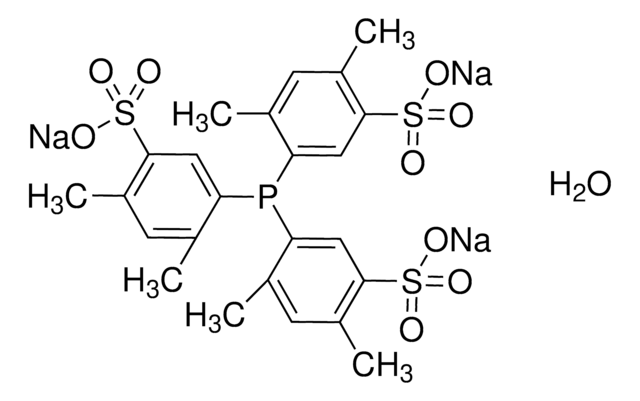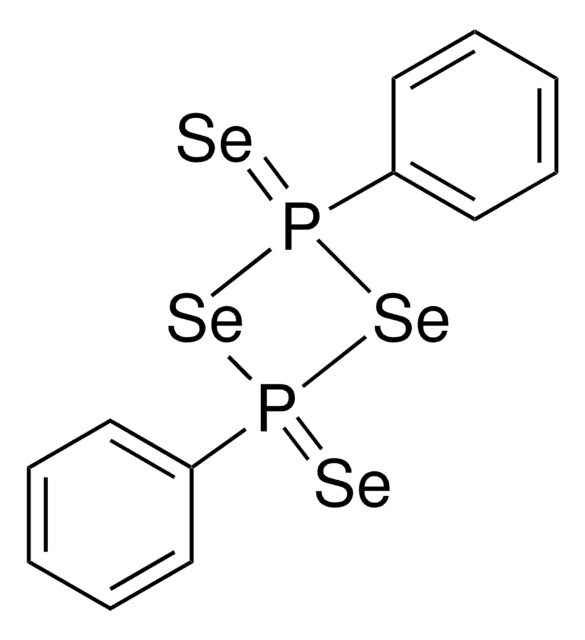08902
Triphenylphosphine oxide
analytical standard
Synonim(y):
Ph3PO, TPPO, Triphenyl phosphorus oxide, Triphenylphosphine monoxide
About This Item
Polecane produkty
klasa czystości
analytical standard
Poziom jakości
Próba
≥98.5% (HPLC)
okres trwałości
limited shelf life, expiry date on the label
metody
HPLC: suitable
gas chromatography (GC): suitable
mp
150-157 °C (lit.)
Zastosowanie
pharmaceutical
format
neat
ciąg SMILES
O=P(c1ccccc1)(c2ccccc2)c3ccccc3
InChI
1S/C18H15OP/c19-20(16-10-4-1-5-11-16,17-12-6-2-7-13-17)18-14-8-3-9-15-18/h1-15H
Klucz InChI
FIQMHBFVRAXMOP-UHFFFAOYSA-N
Szukasz podobnych produktów? Odwiedź Przewodnik dotyczący porównywania produktów
Powiązane kategorie
Zastosowanie
- Fluoride sensing in coordination polymers: Triphenylphosphine oxide is utilized in the development of lanthanide-based coordination polymers for selective fluoride sensing, demonstrating its utility in intramolecular proton transfer mechanisms for enhanced detection capabilities (Singh et al., 2024).
- NMR shielding calculations: The compound′s influence on solvent effects and convergence of phosphorus-31 NMR shielding calculations is explored, highlighting its role in computational chemistry for better understanding molecular interactions (Calcagno et al., 2024).
- Hydrogen bond characterization: Triphenylphosphine oxide is investigated for its interactions with substituted phenols, where shifts in phosphorus-oxygen stretching bands are analyzed to characterize hydrogen bonds, enhancing our understanding of molecular dynamics in phosphine oxides (Kostin et al., 2024).
- Advances in utilization: A review discusses the broad applications of triphenylphosphine oxide beyond its traditional uses, focusing on its emerging roles in various chemical transformations and its potential in catalytic processes (Zhang and Han, 2024).
- Covalent bonding studies with lanthanides: The role of 4f-orbitals in forming covalent bonds between lanthanides and triphenylphosphine oxide is examined using X-ray absorption spectroscopy and density functional theory, providing insights into the electronic structure and bonding behavior in these complexes (Zhang et al., 2024).
Komentarz do analizy
Inne uwagi
The collision cross section (CCS) measurement was provided by Waters Corporation, using the SYNAPT XS mass spectrometer.
For a description and overview of how ion mobility enables the measurement of the CCS of an ion visit ims.waters.com.
Further information on the SYNAPT XS mass spectrometer can be found on the IMS microsite and product webpage.
TWCCS measurements are expected to be within 2% of this reference value.
P/N 08902 is part of the Waters Extractables & Leachables UNIFI scientific library which can be downloaded from Waters Marketplace.
Polecane produkty
Hasło ostrzegawcze
Warning
Zwroty wskazujące rodzaj zagrożenia
Zwroty wskazujące środki ostrożności
Klasyfikacja zagrożeń
Acute Tox. 4 Oral - Aquatic Chronic 3
Kod klasy składowania
11 - Combustible Solids
Klasa zagrożenia wodnego (WGK)
WGK 2
Temperatura zapłonu (°F)
356.0 °F
Temperatura zapłonu (°C)
180 °C
Choose from one of the most recent versions:
Masz już ten produkt?
Dokumenty związane z niedawno zakupionymi produktami zostały zamieszczone w Bibliotece dokumentów.
Nasz zespół naukowców ma doświadczenie we wszystkich obszarach badań, w tym w naukach przyrodniczych, materiałoznawstwie, syntezie chemicznej, chromatografii, analityce i wielu innych dziedzinach.
Skontaktuj się z zespołem ds. pomocy technicznej









